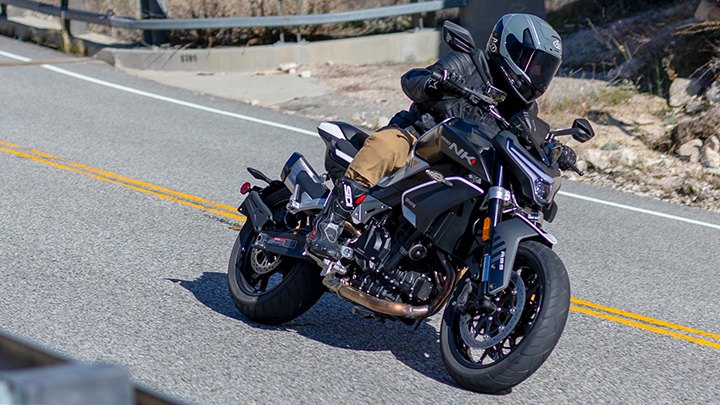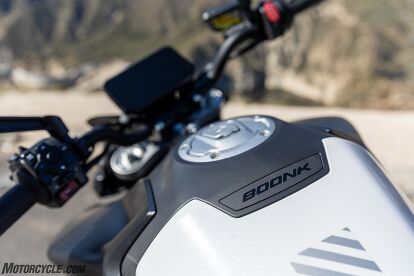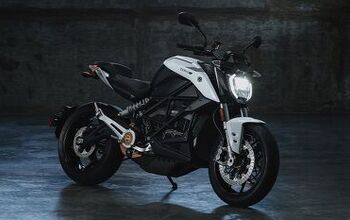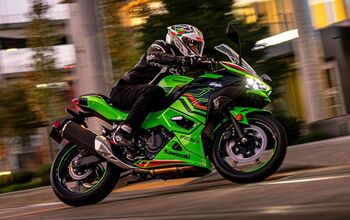2024 CFMOTO 800NK Review

This re-skinned 790 Duke is out to change what you think about CFMOTO
All it takes is the title of this review to bring out the haters. If that’s you, then you see CFMOTO, and if you’ve been following the motorcycle space for a while, you know this is the latest motorcycle brand to come out of China (they’ve actually been making bikes for a while, but that’s besides the point). Then comes the hatred and the vitriol for all the usual reasons lobbied towards the People’s Republic. For those newer to the moto scene, CFMOTO’s origin country may be a surprise to you – or you may not even care.
2024 CFMOTO 800NK
The KTM 790 Duke for those who want something a little softer, a little less committed, and a little cheaper. It's very similar in a lot of ways, but the price difference makes itself felt in others.
Editor Score: 83.0%
Engine | 18.5/20 | Suspension | 11/15 | Transmission | 8/10 |
Brakes | 8/10 | Instruments | 4/5 | Ergonomics | 8/10 |
Appearance | 8.5/10 | Desirability | 8/10 | Value | 9/10 |
Highs
- It's hard to fault that engine
- Very nice fit and finish
- Good value for the money
Sighs
- Suspension could be problematic for lighter riders
- Awkward ankle placement due to passenger peg
- Cruise control tops out at 80 mph
Getting into geopolitics is definitely not where this story is going. This is Motorcycle.com, and as the name implies, we cover motorcycles – yes, including Chinese ones. And now that CFMOTO (yes, its full name is capitalized) falls under the Pierer Mobility umbrella, like it or not, you can expect to see more CFMOTOs building a foothold in the market, not less. In fact, you’ve probably already seen it, as the company is coming on strong with a variety of bikes that have gone on to impress their respective reviewers.
Enter The 800NK
Its latest example is this, the 800NK. Effectively a KTM 790 Duke with different clothes, you could think of the 800NK in a few different ways. First is the “poor man’s” KTM 790 Duke. With essentially the same engine and frame as the 790, the NK draws attention with its $8,499 price tag – undercutting the KTM by at least $500 (probably more, but as of this writing, 2024 790 Duke prices haven’t been announced). Second is the alternative for those who don’t like orange – the 800NK comes in either white or black. Then there’s the obvious styling differences. It’s inevitable to compare the 800NK to the 790 Duke, so let’s get that out of the way right off the bat.
For starters, yes, the engine is the same basic 799cc parallel-Twin. However, exterior differences will show CFMOTO stamped on the cases instead of KTM. Inside, the 800NK is slightly detuned compared to the KTM, as you’ll see on the dyno chart below. CFMOTO claims 100 hp at the crankshaft and 59 lb-ft of torque. When I had the bike on the dyno, it put out about 88 hp to the rear wheel at 8,700 rpm and 58.0 lb-ft of torque at 6,000 rpm – healthy, but noticeably down versus the 790 Duke. A major omission from the 800 is the KTM’s quickshifter in both directions, but unlike the KTM, the 800 makes up for it by adding cruise control standard. The 800NK also doesn’t come with traction control, which, to us, seems like a pretty big cut in order to meet a price point. Like the KTM, the CFMOTO also has ride modes – three different ones in the 800’s case: Sport, Street, or Rain. But considering there is no traction control, all the ride modes do is change the throttle sensitivity.
The engine is also attached to the same frame as the KTM, but the subframe is a different piece, as is the swingarm. From a component standpoint, the biggest difference from the KTM is the 800NK’s use of KYB suspension – not WP – at both ends. The inverted fork offers preload, rebound, and compression adjustments, while the shock lets you change preload and rebound. J.Juan brakes are similar components on both the KTM and CF, but where the 800NK uses radial-mount four-piston calipers with clear J.Juan branding, the 790 Duke calipers have KTM boldly along the side. Both clamp on 320mm discs up front. There’s a 260mm disc in the rear with a two-piston caliper.
Up-spec versions of the 800NK offered in other markets include things like a quickshifter, but for the US anyway, we’re only getting one version of the bike. Theoretically, whatever parts that fit on the KTM should also work on the CFMOTO, but you may need to make some home-brewed mods or reflash the ECU to accept some or all of the modifications.
From there, the next biggest difference between this and the KTM is the five-inch TFT display on the 800NK. It’s a black background with predominantly white lettering that’s easy to read even in harsh light. The font looks much more modern than the block letters used on KTMs and the overall display looks more elegant and visually pleasing compared to the KTM.
Riding Impressions
It’s hard not to walk up to the 800NK and not think it’s going to be awfully similar to a 790 Duke…but cheaper. Then there’s the inevitable question of “Is a Chinese-made motorcycle any good?”
Let’s answer the second question first. Again, taking geopolitics out of the equation, if you never read the sticker on the frame, you’d never guess the 800NK was made in China. The fit and finish is as high as any Japanese bike we’ve tested, with panel gaps all slim and even, no unsightly wiring or cabling showing, and no evidence at all that this bike is “cheap.”
And that’s not just me talking either; on a recent trip to visit Chuck Graves, the namesake of Graves Motorsports, he stopped our discussion after he heard I rode a CFMOTO to his shop and parked it out front. “Let’s go see it!” he said, excitedly.
He looked it over thoroughly, with a keen eye the likes of someone with experience like him would do, and came back with, “This thing is really nice. Even down to the hardware like the bolts.” Admittedly, I don’t really pay attention to the bolts that come on new bikes unless I need to change their tires, but if Chuck says the bolts are nice, then I’ll take his word for it.
Really, the only benchmark I had for the 800NK was my experience riding the CL700 for the $7000 Shootout. The CL700 is a different bike entirely from the 800NK, with a completely different engine, but one thing they both have in common is nice fit and finish. Where they differ is with the engine (and the awkward ergos of the 700). The CL700 fueling was terrible down low before delivering a huge rush as the rpm screams toward redline. The 800NK couldn’t be more different. As you can see in the dyno chart, the fueling is relatively smooth with a nice curve from the bottom to almost the top – there’s a noticeable dip as the engine gets within 500 rpm of redline. The 58.0 lb-ft of torque hits nicely off the line and looks better in the low- and mid-range than the last 790 we tested. And the 88 horses on top are there to carry you through – all with a nice throaty exhaust note to boot.
Sometimes on bikes with ride modes, I ignore the lower ones and put the bike straight into the most aggressive. History has taught me that the lower modes are too reserved and not responsive enough for my taste. With the 800NK I started off in Street mode, the middle setting, mainly because I received the bike straight from the dealer with only two – yes, two – miles on the odometer and I was feeling sympathetic.
The first few miles were spent gingerly riding the bike before I remembered a conversation I had with a rep from another manufacturer (who shall remain nameless). In it, he told me they ride the bikes hard the minute they’re uncrated before the media gets a hold of them. When there’s a fleet of bikes ready for anxious motojournos and only a handful of people to ride them, they don’t have the time to break them in easily. Not only that, but mechanical and manufacturing tolerances have really gotten better over the last 20 years, to the point that certain OEMs don’t bother to gently break in their bikes for the media. And so, neither did I.
There was also a practical reason I changed out of Street mode – the throttle response was too slow. I’d have to turn my right wrist quite a bit before the engine would respond. When riding on the freeway and I needed to pass a slower vehicle quickly, I wanted the immediacy of that 800cc Twin to move me away. Switching to Sport mode solved that.
In Sport mode, the full potential of the engine is unleashed (to be clear, you get full power in all three modes) with power applied in a manner that’s more closely tied to when, and how much, you’re actually turning the throttle. It’s at this point that one can’t help but draw comparisons between the 800NK and its orange counterpart.
This engine has been a favorite of ours since we first threw a leg over it (and that love grew even more when KTM turned it into an 890), and those same characteristics remain with the CFMOTO. The seemingly instant torque off the bottom is fun to play with and it’s also practical for everyday riding, when you’re never exploring with the upper ranges of the revs. Of course, when you do find yourself in play mode, the power is still there up top to take advantage of. Then, rowing through the gears is slick and seamless, as the clutch pull is light and a positive tap with your toe will get you the gear you want. Remember, there’s no quickshifter, so shifts are done the old fashioned way. And while we generally prefer a quickshifter in most cases, if you have to do it manually, this is not a bad gearbox to do it on. A slipper clutch comes standard for those inevitable botched downshifts.
But – and there’s always a but – while the sensitivity of the throttle in Sport mode is an asset when the roads are smooth, it’s also its downfall when the road is not. It’s hard to modulate the throttle over bumpy and rough roads, as each bump and jolt will move your throttle hand a little bit, and that little bit is enough to open and close the throttle butterfly slightly. The result is a jerky ride. An ideal setting for everyday use would be something in between Sport and Street. Something a little more responsive than Street, but less twitchy than Sport.
On the bright side, freeway riding in Sport is still the way to go because you can tame that instant throttle reaction when you’re just burning away miles with cruise control – a very notable distinction that the 790 Duke doesn’t have. Operating it is very simple with the switch on the left bar, and you can adjust the speed by one mile-per-hour increments. However, one of my biggest complaints about the bike overall is the cruise control doesn’t go past 80 mph. I discovered this while traveling an indicated 85 mph on the highway, setting the cruise, letting go of the throttle, and feeling the sudden deceleration as the bike slowed to 77 mph before picking back up to 80 mph. Meanwhile, the looming grill of the car behind me suddenly got huge in both of my mirrors. Pressing the button to increase my speed did nothing. Cruise control was topping at 80 mph – or 5,000 rpm in top gear.
While they won’t outright say it, CFMOTO is positioning the 800NK to be a little more civilized than the Duke. Where KTM is Ready To Race, the 800NK is ready to have fun. The biggest example of this is in the seating position. I wouldn’t call the Duke committed, but you do sit with a forward lean, ready to attack. The 800NK puts you more upright, in a neutral position. It’s comfortable and certainly less committed, but at least for my 5-foot, 8-inch frame, my torso became a sail on the freeway. Sitting up normally, that extra rearward lean compared to the KTM was all it took to go from slicing through the wind to catching all of it in the chest. It really becomes noticeable at highway speeds. Of course, your experience may vary depending on your size. Fortunately for me, there’s plenty of space to move around in the seat to hunch down a little and cut through the wind. To that end, the seat itself is surprisingly comfortable. It doesn’t look it, but there’s a decent amount of padding to resist the urge to get up and redistribute the blood flow around your butt.
As we got up into the hills, it would be easy to assume the 800NK would behave like its orange sibling. For the most part, it does. The engine has no problem moving you along, and you’re encouraged to do so whenever you hear the exhaust roar bouncing off the mountain walls. Since the 800NK utilizes the same main frame as the KTM, the playful nature of the chassis remains. It’s easy to change direction with the 800, no doubt helped by the leverage of the handlebar. If there is a small niggle, it’s the right footpeg bracket for the passenger. It has to extend outward a considerable amount to avoid the exhaust and ends up pushing out the rider’s right boot into a weird angle. It’s annoying in a straight line and just gets even more annoying in right turns. Otherwise, the 800NK tracks well and changes direction with ease – though it does prefer smooth inputs instead of being manhandled.
The reason for this comes down to suspension. CFMOTO relies on KYB suspension instead of WP (which KTM/Pierer Mobility owns, by the way) for the 800NK, and on smooth roads, the 800NK behaves like a street-focused bike should. Bumps were well damped but still on the sporty side, meaning just a tiny bit firm.
Things change when the road surface sucks – and it doesn’t get any better if the choppy roads are also full of twists and turns. If you’re carrying anything resembling pace, stutter bumps and rough surfaces will upset the suspension, as if the valving inside the fork can’t open fast enough to let the fluid flow through. The result feels similar to a locked fork. At that point, if you try to go faster the problem gets worse. All you can do then is to slow down and let the fork recover. No bueno. Making matters worse is the lack of a steering damper – even though the lower triple tree clearly has a mount where one is supposed to go. Fortunately, you can adjust the clickers at both ends, but softening compression damping addresses the problem somewhat, at the expense of a softer fork everywhere else. It was definitely a strange and unsettling phenomenon.
Despite not saying Brembo along the side of them, the J.Juan calipers and master cylinder didn’t leave much to complain about. Now that J.Juan is owned by Brembo, the two names could be considered synonymous at this point (ok, not really), but whatever name is on them doesn’t take away the smooth, yet strong stopping power the 800NK has at its disposal. Better still – steel-braided lines come standard.
A Lot Of Bike At An Affordable Price
Stop to consider for a second how much the 800NK costs – $8,499. As I quickly scroll down the list of bikes at this price point I see things like the $8,199 Yamaha MT-07, $9,399 Honda CB650R, $8,999 Suzuki GSX-8S, and $8,169 Kawasaki Z650. All of them have smaller engines than the CFMOTO, and none of them have the fun factor of the 800NK. To get an evenly-matched engine (or better) and other components, you’re jumping significantly in price.
This alone gives the 800NK a value proposition that sets it apart in the class. For all my gripes about the bike, those things are generally insignificant and can likely be addressed through the aftermarket, even if that means shopping for 790 Duke parts (Disclaimer: again, I’m not completely certain parts are interchangeable, and as of press time, the response I got from CFMOTO were that they weren’t completely sure either, but it seems like they would be).
What you get with the 800NK is a fun bike with an engine that’s hard to fault, wrapped in a chassis that’s comfortable for an all-day ride, especially if much of your day is spent on fun roads. The catch is that you’ll have to use the money you’re saving to really get it dialed for you. But like I said at the top of the review, if you don’t like orange, or the way the KTM is styled, the 800NK makes a completely viable alternative. Regardless of where it was made.
Troy's Gear

- Helmet: 6D ATS-1R Alpha
- Jacket: Alpinestars Proton Waterproof
- Airbag: REV’IT! Avertum Tech-Air Airbag
- Pants: REV’IT! Davis Jeans
- Gloves: Alpinestars SMX-2 Air Carbon
- Footwear: Sidi ST Air boots
2024 CFMOTO 800NK | |
|---|---|
MSRP | $8,499.00 |
Type | 799cc Parallel-Twin |
Bore and Stroke | 88.0 mm x 65.7 mm |
Fuel System | Bosch EFI |
Valve Train | DOHC, 4 valves per cylinder |
Transmission | 6-speed |
Final Drive | Chain |
Front Suspension | KYB 43mm upside-down fork, preload, rebound & compression adjustable |
Rear Suspension | KYB single shock, preload & rebound adjustable |
Front Brake | J. Juan 320mm dual disc, radial mount 4-piston caliper |
Rear Brake | J. Juan 260mm single disc, 2-piston floating caliper |
Front Tire | 120/70ZR17 |
Rear Tire | 180/55ZR17 |
Rake/Trail | 24° / 3.8 inches |
Wheelbase | 57.8 inches |
Seat Height | 31.5 inches |
Curb Weight | 410 pounds (claimed) |
Fuel Capacity | 4.0 gallons |
Additional Features | LED headlights, taillights and signal lights; 5” TFT display with Bluetooth and CFMOTO Ride App connectivity, electronic throttle, sport, street and rain ride modes, cruise control |
Available Colors | Nebula White, Zircon Black |
We are committed to finding, researching, and recommending the best products. We earn commissions from purchases you make using the retail links in our product reviews. Learn more about how this works.
Become a Motorcycle.com insider. Get the latest motorcycle news first by subscribing to our newsletter here.

Troy's been riding motorcycles and writing about them since 2006, getting his start at Rider Magazine. From there, he moved to Sport Rider Magazine before finally landing at Motorcycle.com in 2011. A lifelong gearhead who didn't fully immerse himself in motorcycles until his teenage years, Troy's interests have always been in technology, performance, and going fast. Naturally, racing was the perfect avenue to combine all three. Troy has been racing nearly as long as he's been riding and has competed at the AMA national level. He's also won multiple club races throughout the country, culminating in a Utah Sport Bike Association championship in 2011. He has been invited as a guest instructor for the Yamaha Champions Riding School, and when he's not out riding, he's either wrenching on bikes or watching MotoGP.
More by Troy Siahaan



























































































Comments
Join the conversation
How is the 800NK down on rear wheel torque compared to the KTM 790 Duke, when it's 58 for the 800NK and 58 for the 790 Duke? (same dyno numbers for RW-torque).
FYI - KTM 790 Duke does not come with a Quick Shifter, it's optional (extra cost).
Also, the suspension on the 790 Duke is non-adjustable on the front and only adjustable for preload on the rear. Where the 800NK is fully adjustable on the front and has preload and rebound adjustability on the rear.
Also, the KTM 790 Duke comes with 300mm front rotors and a 240mm rear one.
Where the 800NK has larger front and rear rotors----320mm (front)/ 260mm (rear).
So, seems like the CFMOTO 800NK is much better equipped than the KTM 790 Duke.
The engines are exactly the same, just little better tune for the 790 Duke.
KTM 790 Duke - 103 hp/ 64 lb-ft torque (at crank)
CFMOTO 800NK - 100 hp/ 59.7 lb-ft torque (basically 60)
This re-skinned 790 Duke is actually a little better than the KTM less the engine tune. The CFMOTO 800NK has better brakes (larger rotors), more adjustability for suspension, better TFT display, and cruise control. And for most (not me) better aesthetics. I can't wait to see it in a Naked Middleweight Shootout vs the Japanese and Brit bikes. I'm sure it will fare well.